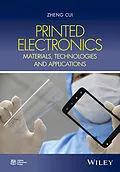This book provides an overview of the newly emerged and highly interdisciplinary field of printed electronics Provides an overview of the latest developments and research results in the field of printed electronics Topics addressed include: organic printable electronic materials, inorganic printable electronic materials, printing processes and equipments for electronic manufacturing, printable transistors, printable photovoltaic devices, printable lighting and display, encapsulation and packaging of printed electronic devices, and applications of printed electronics Discusses the principles of the above topics, with support of examples and graphic illustrations Serves both as an advanced introductory to the topic and as an aid for professional development into the new field Includes end of chapter references and links to further reading
Autorentext
Prof Zheng Cui, Chinese Academy of Sciences, China
Zheng Cui?obtained a?PhD in electronic engineering in 1988 and became a Visiting Fellow at the Microelectronics Research Center, Cambridge University, UK, in 1989. Cui?joined the Rutherford Appleton Laboratory, UK, in 1993 and subsequently became a Principal Scientist and group leader there in 1999. In October 2009, after working in the UK for 20 years, Cui returned to China and founded the Printable Electronics Research Center at the Suzhou Institute of Nanotech, which was the first research center dedicated to printed electronics R&D in China.
Dr Song Qiu, Chinese Academy of Sciences, China
Song Qiu received a B.S. Polymer Materials and Engineering in 2000, followed by a PhD in Polymer Chemistry and Physics?from Jilin University in 2005.
Dr Jian Lin,?Chinese Academy of Sciences, China Dr. Jianwen Zhao,?Chinese Academy of Sciences, China Dr. Chang-Qi Ma,?Chinese Academy of Sciences, China Dr. Zheng Chen, Chinese Academy of Sciences, China Dr. Wenming Su, Chinese Academy of Sciences, China Preface xii 1 Introduction 1 1.1 What is Printed Electronics? 1 1.2 The Importance of Developing Printed Electronics 11 1.3 Multidisciplinary Nature of Printed Electronics 15 1.4 Structure and Content of the Book 17 References 19 2 Organic Printable Electronic Materials 21 2.1 Introduction 21 2.2 Organic Conductive Materials 22 2.2.1 Characteristics of Organic Conductive Materials 22 2.2.2 History of Organic Conductive Materials 23 2.2.3 Conductive Polymer 23 2.2.3.1 Structural Conductive Polymer 23 2.2.3.2 Composite Conductive Polymer 25 2.2.4 PEDOT 25 2.3 Printable Organic Small Molecular Semiconductors 27 2.3.1 Fused Aromatic Compounds 28 2.3.2 Heterocyclic Sulfur Compounds and Oligothiophenes 30 2.3.3 Other Materials with High Mobility 33 2.4 Printable Polymeric Semiconductor 34 2.4.1 Ptype Polymer Semiconductors 35 2.4.1.1 Sulfurcontaining Heterocyclic Polymeric Semiconductors 35 2.4.1.2 Phenylcontaining Polymeric Semiconductors 37 2.4.1.3 Other ptype Polymeric Semiconductors 39 2.4.2 Ntype Polymer Semiconductors 39 2.4.3 Ambipolar Transistor and Related Polymer Materials 41 2.4.4 Outlook 43 2.5 Other Printable Organic Electronic Materials 44 2.5.1 Organic Insulating Materials 44 2.5.2 Organic Materials for Sensors 47 2.6 Summary 49 References 49 3 Inorganic Printable Electronic Materials 54 3.1 Introduction 54 3.2 Metallic Materials 56 3.2.1 Metallic Ink 56 3.2.2 Postprinting Process 63 3.2.3 Metal Nanowire 64 3.3 Transparent Oxide 66 3.3.1 Transparent Oxide Semiconductor and Conductor 66 3.3.2 Low Temperature Solution Processing 68 3.3.3 Doped Transparent Oxide Nanoparticles 71 3.4 Singlewall Carbon Nanotube 72 3.4.1 Preparation and Selective Chemistry of SWNT 72 3.4.2 Purification of SWNT 76 3.4.3 Metallic SWNT Thin Film 77 3.4.4 Semiconducting SWNT Thin Film 79 3.5 Graphene 83 3.6 Silicon and Germanium 86 3.7 Metal Chalcogenides Semiconductor and Quantum Dots 90 3.7.1 Metal Chalcogenides Semiconductor 90 3.7.2 Quantum Dots 90 3.8 Nanoparticle/Polymer Dielectric Composites 92 3.9 Summary 95 References 96 4 Printing Processes and Equipments 106 4.1 Introduction 106 4.2 Jet Printing 108 4.2.1 Inkjet Printing 108 4.2.1.1 Working Principles 108 4.2.1.2 Pattern Preparation 108 4.2.1.3 Application in Printed Electronics 110 4.2.2 Aerosol Jet Printing 111 4.2.2.1 Working Principle 112 4.2.2.2 Pattern Preparation 112 4.2.2.3 Advantages and Challenges 113 4.2.3 Electrohydrodynamic Jet Printing 114 4.2.4 Advantages and Disadvantages 114 4.3 Direct Replicate Printing 115 4.3.1 Screen Printing 116 4.3.1.1 Working Principle 116 4.3.1.2 Screen Mask 117 4.3.1.3 Advantages and Disadvantages 118 4.3.1.4 Applications 118 4.3.2 Gravure Printing 118 4.3.2.1 Principle and System 118 4.3.2.2 Gravure Plate 120 4.3.2.3 Advantages and Disadvantages 120 4.3.2.4 Applications in Printed Electronics 121 4.3.3 Flexographic Printing 122 4.3.3.1 Principle and System 122 4.3.3.2 Printing Plate 123 4.3.3.3 Advantages and Disadvantages 123 4.3.3.4 Applications in Printed Electronics 125 4.4 Indirect Replicate Printing 125 4.4.1 Offset Printing 125
Jian Lin received his PhD degree in Polymer Chemistry and Physics from Changchun Institute of Applied Chemistry, Chinese Academy of Sciences in 2008.
Jianwen Zhao received his PhD degree in Technical Institute of Physics and Chemistry, Chinese Academic of Science, in 2008.
Chang-Qi Ma received his bachelor's degree in Chemistry from Beijing Normal University in 1998. In 2003 he obtained his PhD degree at the Technical Institute of Physics and Chemistry, Chinese Academy of Sciences in Beijing with Professor B.-W. Zhang.
Zheng Chen received the B.S. degree in materials physics and PhD degree in condensed matter physics from the University of Science and Technology of China, in 2002 and 2007, respectively.
Wenming Su is anAssociate professor of Printable Electronics Research Center, Suzhou Institute of Nanotech, Chinese Academy of Sciences.
Inhalt
Zheng Cui
Song Qiu and Chunshan Zhou
Zheng Chen
Jian Lin
